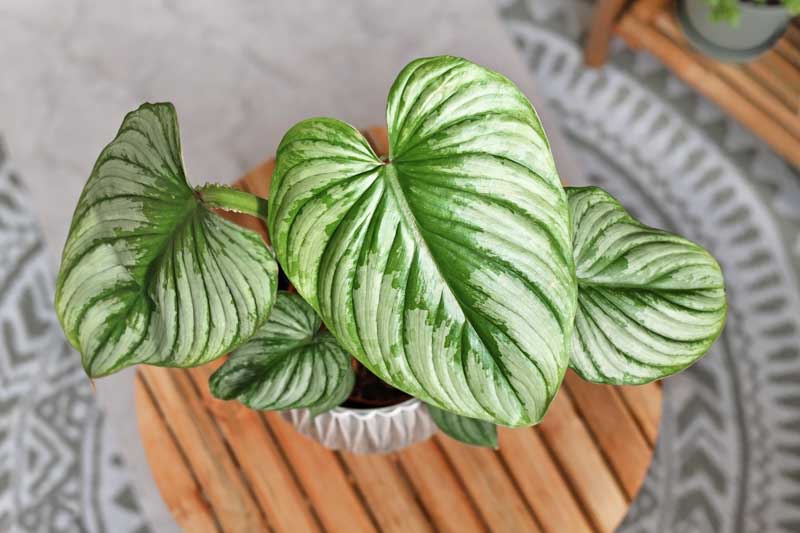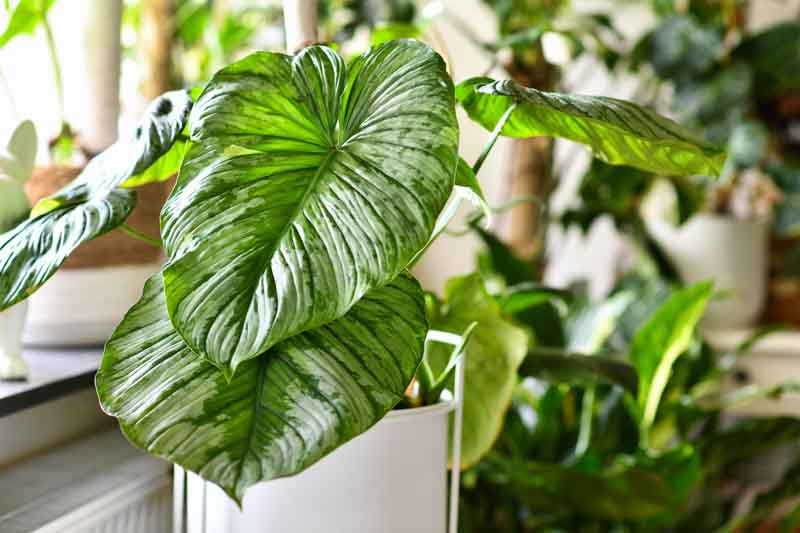Blotched Philodendron
Philodendron mamei is a captivating species within the diverse Philodendron genus, renowned for its unique foliage and ground-crawling growth habit. Native to the tropical forests of Ecuador, this plant embodies the lush, verdant beauty of its habitat, making it a sought-after specimen for indoor gardeners and plant enthusiasts alike.
Philodendron mamei stands out with its large, heart-shaped leaves, which can span over a foot in width. The leaves are a deep green, adorned with silvery-white variegation and prominent veins that give them a textured appearance. The undersides of the leaves are a lighter green, contributing to the plant’s overall aesthetic appeal.
Native: Originating from the dense, moist forests of Ecuador, Philodendron mamei thrives in humid, shaded environments. In its natural setting, it grows along the forest floor, utilizing the rich organic matter available in its habitat to support its lush growth. It belongs to the arum family (Araceae), along with Zantedeschia (Calla Lily), Caladium (Angel Wing), Monstera (Swiss Cheese Plant), or Colocasia (Elephant Ear).
Plant Type and Habit: Philodendron mamei is an evergreen perennial known for its creeping habit. It spreads across the ground with its large leaves held aloft on sturdy, short stems. This growth pattern allows it to cover significant ground area, making it an impressive ground cover in its native habitat and a striking potted plant in indoor settings.
Size: In cultivation, Philodendron mamei typically reaches a height of about 3-4 feet (90-120 cm). Its size and growth habit make it a statement piece in any indoor garden.
Foliage: The foliage of Philodendron mamei is its most notable feature, with each leaf presenting a unique pattern of silvery variegation against a deep green backdrop. The leaves are not only visually striking but also velvety to the touch, adding a tactile dimension to its appeal.
Hardiness: If planted outdoors, this plant is hardy in USDA zones 10-11. It is best suited to indoor environments where temperatures can be kept consistent, ideally between 60-85°F (15-29°C). It is not frost-tolerant and should be protected from cold drafts.
Uses: Philodendron mamei is primarily used for ornamental purposes, thanks to its distinctive appearance. It makes an excellent indoor plant, adding a lush, tropical feel to living spaces, offices, and greenhouses.
Toxicity: Philodendrons are toxic to humans, cats, and dogs if ingested. They contain calcium oxalate crystals that can cause mouth and stomach irritation. Contact with the sap may cause skin irritation.
Benefits: Beyond its decorative value, it also serves as an air purifier, improving indoor air quality by filtering out certain toxins. It’s well-suited for placement in living rooms, offices, or any space that could benefit from a splash of vivid greenery.

Light: Prefers bright, indirect light. Avoid direct sunlight, which can scorch its leaves. A spot near a window with a sheer curtain is ideal.
Soil: Requires well-draining, rich, organic soil. A mix containing peat moss, perlite, and compost is perfect for retaining moisture while providing adequate drainage.
Water: Water when the top inch of soil feels dry. Philodendron mamei likes consistent moisture but is susceptible to root rot in overly wet conditions. Ensure good drainage.
Temperature and Humidity: Prefers warm temperatures between 65°F (18°C) and 85°F (29°C). Protect it from drafts and ensure it’s not exposed to temperatures below 55°F (13°C). Thrives in high humidity, ideally above 60%. Use a humidifier, mist the plant regularly, or place it on a pebble tray with water to increase humidity around it.
Fertilization: Fertilize monthly during the growing season (spring and summer) with a balanced, liquid fertilizer diluted to half strength. Reduce fertilization in fall and winter.
Pruning: Prune any yellow or damaged leaves to encourage healthy growth and maintain a tidy appearance. Use clean, sharp scissors or pruning shears.
Repotting: Repot every 2-3 years or when the plant becomes root-bound. Spring is the best time for repotting, allowing the plant to recover and grow actively in the growing season.
Propagating Philodendron plants is a straightforward and rewarding process, allowing you to expand your collection or share with friends and family. The most common method is stem cuttings, which can be rooted in water or soil. Here’s how to do it:
Choose a Healthy Stem: Look for a healthy stem with at least 2-3 leaves and a few nodes (the points on the stem where leaves attach and roots tend to grow).
Make the Cut: Using a clean, sharp knife or scissors, cut just below a node. The cutting should be about 4-6 inches long.
Prepare the Cutting: Remove any leaves that would be submerged when you place the stem in water to prevent rot.
Root in Water: Place the cutting in a glass or jar of water, ensuring the node is submerged. Leave the leaves out of the water. Place the jar in a warm, bright spot with indirect light.
Change the Water Regularly: Refresh the water every few days to keep it clean, which helps prevent bacterial growth.
Wait for Roots: Roots should start to emerge from the nodes in about 2-4 weeks. Wait until the roots are a few inches long before potting.
Potting: Once the roots are sufficiently developed, plant the cutting in a pot with well-draining soil. Care for it as you would a mature Philodendron.
Prepare Your Cutting: Follow the same steps as above to select and cut a healthy stem section.
Rooting Hormone (Optional): Dip the cut end of the stem in rooting hormone powder to encourage root growth. This step is optional but can enhance rooting success.
Plant the Cutting: Fill a pot with a well-draining potting mix. Make a hole in the center and insert the cut end of the stem, ensuring at least one node is buried beneath the soil surface.
Water and Cover: Water the soil lightly to settle it around the cutting. To create a humid microenvironment, you can cover the pot with a plastic bag or place it in a propagator. Ensure the leaves are not touching the plastic to prevent rot.
Care for Your Cutting: Place the pot in a warm, bright location with indirect light. Keep the soil consistently moist but not waterlogged.
Wait for Growth: In a few weeks, the cutting should start to root. You can gently tug on the plant after about 4 weeks; if there’s resistance, roots have formed.

Philodendrons can encounter pests, diseases, and other common problems, especially when grown indoors.
Spider Mites: These tiny pests can be identified by the fine webs they weave on the plant. They cause yellowing or speckled leaves. Increase humidity around the plant and wash it with a strong stream of water. For severe infestations, use insecticidal soap or neem oil.
Mealybugs: These white, cottony pests tend to cluster in leaf axils and under leaves, sucking sap and weakening the plant. Remove with alcohol-dipped cotton swabs or apply neem oil.
Aphids: Small, soft-bodied insects that can be green, black, brown, or pink, aphids typically feed in groups on the undersides of leaves. Combat them with a gentle spray of water, neem oil, or insecticidal soap to protect the plant’s health and appearance.
Scale insects: Hard or soft-bodied insects that attach themselves to the stems or leaves, causing yellowing and growth stunting. Scrape off with a fingernail or use a cotton swab dipped in rubbing alcohol. Insecticidal soap or neem oil may also be used.
Root rot: Overwatering is the primary cause, leading to brown, mushy roots and yellowing leaves. Reduce watering, improve drainage, and repot the plant into fresh, well-draining soil. Severely affected roots should be trimmed before repotting.
Leaf spot: Fungal or bacterial infections can cause dark or black spots on leaves, often with a yellow halo. Increase air circulation, avoid wetting leaves when watering, and remove affected leaves. Fungicides or bactericides may be necessary in severe cases.
Yellowing Leaves: Often a sign of overwatering or poor drainage. Ensure the plant is in well-draining soil and adjust your watering schedule to allow the soil to dry slightly between waterings.
Brown Leaf Tips: Can indicate low humidity, especially in dry indoor environments. Increase humidity around the plant with a humidifier, pebble tray, or by misting the leaves regularly.
Leaf Scorch: Direct sunlight can cause the leaves to scorch, leading to brown patches or fading of the vibrant leaf colors. Position the plant in a location where it receives bright, indirect light.
Drooping Leaves: This can be a sign of both underwatering and overwatering. Check the soil moisture to determine the cause and adjust your watering accordingly.
Slow Growth or Lack of Color: Insufficient light can lead to less vibrant leaf coloration and slow growth. Ensure your philodendron is receiving enough indirect light to maintain its rich hues and promote healthy growth.
| Hardiness |
10 - 11 |
|---|---|
| Plant Type | Houseplants, Climbers, Perennials |
| Plant Family | Araceae |
| Genus | Philodendron |
| Exposure | Partial Sun |
| Season of Interest |
Spring (Early, Mid, Late) Summer (Early, Mid, Late) Fall Winter |
| Height |
3' - 4' (90cm - 120cm) |
| Maintenance | Low |
| Water Needs | Average |
| Soil Type | Loam, Sand |
| Soil pH | Acid, Neutral, Alkaline |
| Soil Drainage | Moist but Well-Drained |
| Characteristics | Showy, Evergreen |
| Tolerance | Deer, Rabbit |
| Garden Uses | Patio And Containers |
| Hardiness |
10 - 11 |
|---|---|
| Plant Type | Houseplants, Climbers, Perennials |
| Plant Family | Araceae |
| Genus | Philodendron |
| Exposure | Partial Sun |
| Season of Interest |
Spring (Early, Mid, Late) Summer (Early, Mid, Late) Fall Winter |
| Height |
3' - 4' (90cm - 120cm) |
| Maintenance | Low |
| Water Needs | Average |
| Soil Type | Loam, Sand |
| Soil pH | Acid, Neutral, Alkaline |
| Soil Drainage | Moist but Well-Drained |
| Characteristics | Showy, Evergreen |
| Tolerance | Deer, Rabbit |
| Garden Uses | Patio And Containers |
How many Philodendron mamei (Blotched Philodendron) do I need for my garden?
| Plant | Quantity | |
|---|---|---|
| Philodendron mamei (Blotched Philodendron) | N/A | Buy Plants |
Create a membership account to save your garden designs and to view them on any device.
Becoming a contributing member of Gardenia is easy and can be done in just a few minutes. If you provide us with your name, email address and the payment of a modest $25 annual membership fee, you will become a full member, enabling you to design and save up to 25 of your garden design ideas.
Join now and start creating your dream garden!
Create a membership account to save your garden designs and to view them on any device.
Becoming a contributing member of Gardenia is easy and can be done in just a few minutes. If you provide us with your name, email address and the payment of a modest $25 annual membership fee, you will become a full member, enabling you to design and save up to 25 of your garden design ideas.
Join now and start creating your dream garden!